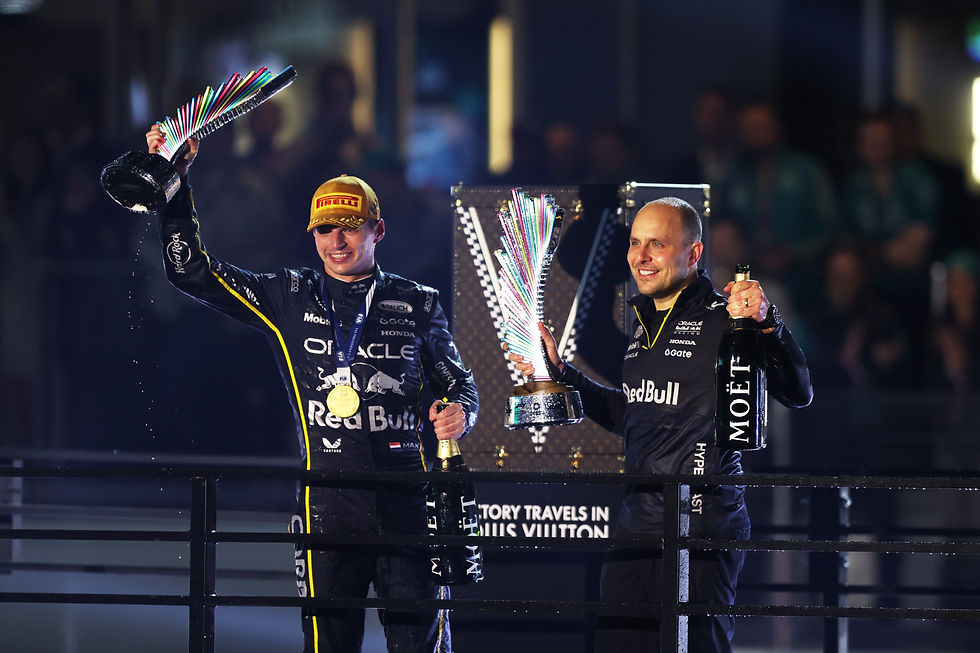Racing Refresh Tech Tuesday: NHRA Top Fuel Dragsters
- Collin Best

- Aug 2, 2022
- 3 min read

(Image via NHRA)
When it comes to speed in motorsports, you look no further than the NHRA. When it comes to power, the first thing you think of is it's Top Fuel dragster category. With speeds well above 300 miles per hour, for thirty-seven drivers in the 2022 NHRA Top Fuel division, each pass is four seconds of high octane power. In this edition of Tech Tuesday, we will look at the science and engineering of the Top Fuel power plant that makes these machines the fastest in the world.
In short, a Top Fuel Dragster is powered by 500 cubic-inch engine that is forged of one piece of solid aluminum that has a power output of over 11,000 horsepower. Which is equal to fifteen IndyCar engines worth of power. The acceleration of these engines is mind boggling that it can go from a standing start to 100 miles per hour in 0.8 seconds. With speeds like that, drivers can experience up to four times the force of gravity on the start which is more than Space Shuttle astronauts experienced at launch. There is no words in the English language that can describe the incredible power that these cars can produce.
Based of the second generation of a V8 engine that dates back to 1964 with the Chrysler RB Hemi. The engine uses a two-valve hemispherical design which is also machined from aluminum. With large valves and the hemispherical design, holds on to heat produced by combustion more efficiently which allows a very high fuel to air ratio that can produce power. But the engine alone doesn't just produce all of the power. The engine is aided by Roots blower supercharger that has the ability to spin at 12,000 revolutions a minute and provides up to 66 pounds of intake pressure and moves up to 3,000 cubic feet per minute is forced into the cylinder to aid the combustion process. To create this power, you need spark plugs. Each cylinder has two spark plugs and are powered by two 44 amp magnetos. Which is the same amount of power that tig welders use to operate. By the end of one run, the spark plugs can actually weld together.
But air is just part of the combustion process. To need fire, you need air and a fuel source to create it. That's where nitromethane comes in to play. Nitromethane or "nitro" for short, is a chemical that has less oxygen than your road car in order to burn more efficiently. In a street car, it takes 2.2 pounds of gasoline with 32 pounds of air in order to have it's most efficient burn. With nitro, 1 pound of nitromethane with 3.7 pounds of air is in order to burn at its most efficient point. This is because it carries its own oxygen in the molecular bonds. Because of this, the fuel injectors can inject 1.2 gallons per second of fuel to power the engine. Also, because there is no radiator in Top Fuel cars, the nitromethane is used to cool the engines until the car runs out of fuel. On a normal run through the burnout to the end of a quarter-mile run, it can use up to 23 gallons of fuel.
Now how do we delivered that power to the track. Well, like most engines it is from the transmission and the clutch. Unlike gears on a Formula One car, NHRA Top Fuel cars are direct drive and use a centrifugal clutch to deliver power. The clutch is made up of a system of timers, levers, and clutch disks that use centrifugal force to throw clutch fingers outward. As they do that they engage more disks until all six are engaged. By the end of the run, all six are welded together due to friction as temperatures can rise up to 3700 degrees.
This concludes another edition of Tech Tuesday. Next weekend, we will be taking a in-depth look at the suspension system of an IndyCar.
For Henry.








Comments